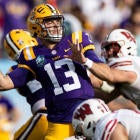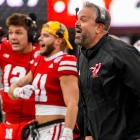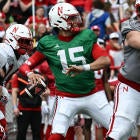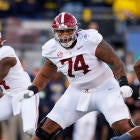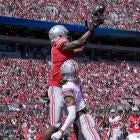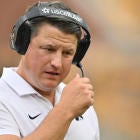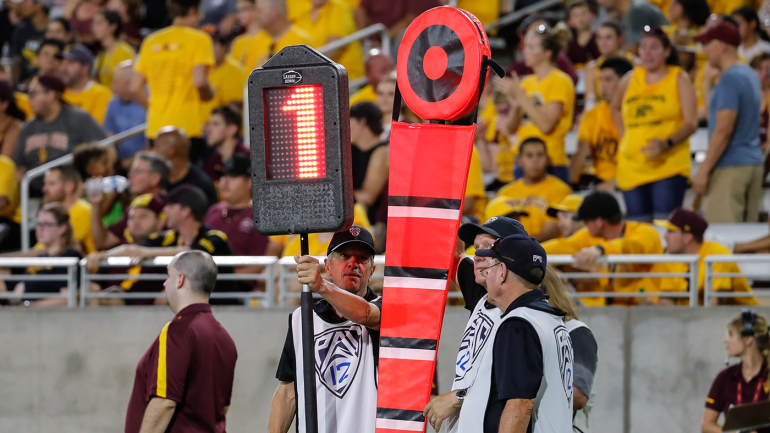
A simple spat over a football rules change has turned into a referendum on the primacy of major-college football itself.
A rule change allowing the clock to run following first downs -- outside of the last 2 minutes of each half -- was approved for Division I and Division II last month. That ended the practice of first-down clock stoppages that dated back to 1968 and served as one of the most notable rules that made the college game distinctive from that in the NFL.
The rationale for the rule change was to limit players' "exposures" to contact, reducing each game by approximately seven plays.
This as the FBS is about to embrace an expanded College Football Playoff that could lead a couple successful teams playing as many as 17 games in a season, up from the current 15 for a national champion. All amid the most litigious era in the game's history.
For what is believed to be the first time, a division was allowed to dissent over such on-field rules. The day before the April 21 rule change was formally announced, the Division III Management Council voted against the proposal, sending it back to the NCAA Football Rules Committee for reconsideration.
The issue could be resolved by June; no one knows for sure. In the new NCAA Constitution adopted last year, it was recommended divisions be allowed to "federate" -- make their own decisions on playing rules.
That federation process is still evolving. Still, this is believed to be that first instance of divisional on-field rules autonomy as the NCAA attempts to streamline and modernize its entire organization. On this small issue, however: A sizable roadblock is developing.
"If it's all about [not] having extra snaps in the season, then why are we extending the [playoff]?" asked Todd Berry, executive director of the American Football Coaches Association.
Berry told CBS Sports that coaches in all three divisions were against the rule change as he reviewed results of an annual AFCA survey. Typically, the AFCA is considered only as a reference resource by the rules committee.
Big Ten officiating supervisor Bill Carollo told CBS Sports he has lodged a complaint against the change with the Playing Rules Oversight Panel. The PROP oversees 15 playing rules committees that formally approve changes.
"There are exceptions," Carollo said, "... but the rules, to me, are the rules."
What do such rules disagreements mean for the future of college sports? Given this newfound federation, a lower division could conceivably vote in a 9-foot basket or 8-point touchdowns.
We're a long way from that, of course, but the door has been cracked open. This has turned out to be not so much a power struggle but a full-on football struggle, not unlike opposing linemen lining up on fourth-and-1. In both cases, first down is at stake.
"We could be playing by different rules," said one rules committee source ominously.
Perhaps that's OK. The three divisions have basically played by the same on-field rules, though they are hardly the same off the field. The FCS allows 63 total scholarships, while the FBS has a max of 85. Roster travel limits can vary by conference. There are also differences in governance and enforcement.
"I don't find it as shocking that the playing rules are going to have some differences as well," said Julie Roe Lach, Horizon League commissioner and former NCAA enforcement director.
"If seven plays come out of the game, fans will never notice it," said Steve Shaw, secretary-editor of the rules committee and national coordinator of officials.
It's possible NCAA divisional football rules head in vastly different directions much the same as the XFL and USFL offer different playing rules compared to the NFL. The 12-member rules committee will give fair consideration to D-III's preference, sources said. The committee is composed of four FBS representatives, two FCS reps and three each from Divisions II and III.
"It probably boils down to what's safest for our players without changing our game because our college football game is different than the NFL and we don't have to mimic that," said Georgia coach Kirby Smart, a member of the rules committee, in January. "Although, we want to make it as safe as possible for our players."
Carollo also oversees officials from six Division III conferences and believes the possibility for confusion exists. He said 80% of his Division III officials also work high school games where the clock stops on first down.
One source close to the discussions was concerned Division III players and officials could be labeled as playing with the "high school rule." The PROP specializes in paying particular attention to player safety and taking into account the "image of the game."
Division III doesn't have the same excesses as the FBS. D-III teams typically play 10 regular-season games, two fewer than their FBS counterparts. In 2022, the average D-III game length was 2:52, 34 minutes shorter than the average FBS game.
The smaller division doesn't have the commercial breaks or lengthy replay stoppages of the FBS.
Division III averaged 132.4 combined plays per game in 2022, that's just 4.2 fewer plays per game than the 136.6 the FBS averaged this season. However, the FBS is already down 6.7 plays plays per game since it spiked with 143.3 in 2014, the highest average for the subdivision since 1982. (Those averages do not include kickoffs, field goals, punts or penalties that aren't accepted.)
If the clock stoppage rule change was instituted across all divisions, a D-III player would lose the equivalent of 4.3 regular-season games (out of 40) across a four-year career. FBS players would lose the equivalent of 5.3 regular-season games (out of 48, based on a 12-game schedule) over four years. As such, the rule change affects the FBS slightly more than it does D-III.
"During the regular season, we have 1:30 kickoff times," said Geoff Dartt, coach of Division III power Mount Union. "A game going a full three hours is extremely rare. I am kind of glad. In Division III, it's not affected us -- at least right now."
"It eliminates valuable snaps for our student-athletes," said Holly Sheilley, athletic director at Transylvania and Division III Management Council chair. "It was not seen as a health and safety issue by our membership but rather a way to speed up a game -- and that is not a concern for Division III."
The rule change is less about the length of games than enhanced game flow and reducing injuries. Not going along with the change seemingly opens up Division III -- and by extension, the NCAA -- to legal liability. If its players are subject to more plays than those in the higher divisions, one could argue a greater likelihood of injury for D-III players. The NCAA continues to fight dozens of lawsuits regarding player safety, as they have over the last couple decades.
"I think there is definitely that potential [of litigation]," said attorney and athlete advocate Maddie Salamone, a former Duke lacrosse player. "When you get into the area where a group of athletes are playing by a different set of rules … then not only are you exposing players to a greater risk, it's acknowledging the dangers of taking a hit in a game."
The last major NCAA football injury survey was conducted from 2014-19. It concluded that the competition-related injury rate was higher than the practice-related injury rate.
Division III is by far the largest in the NCAA with 442 football-playing programs (41% of all NCAA members). Those programs by and large don't award athletic scholarships. A large majority of players receive non-athletic aid.
In that sense, D-III may be considered one of the last outposts of the pure collegiate model. At its foundation, this comes down to D-III not wanting to be defined by the desires of major-college football.
Here we are now with a small -- but contentious -- rules change clearly drawing a line.
The rules committee's history in this area is a bit uneven. In 2006, it determined the clock would start when toe met leather on kickoffs and when the referee gave the "ready for play" signal at the beginning of a possession.
The resulting drop in number of plays per game was so profound that those thought-to-be minor changes ended up being so radical they lasted just one season. That season, total plays declined by more than 13 per game on average. The drop in average yards per team (33) was the most since 1954. The scoring average per team (24.1 points) was the lowest in the last 32 years.
Those changes were reversed before the 2007 season. Berry says the cumulative effect was the large-scale use of the no-huddle offense. Coaches, he said, will further adjust because of the new rule and play even faster.
"There are going to be some unintended consequences," said Illinois coach Bret Bielema said, who suggested he may need to change his approach to game management.
"You watch NFL games, you expect it to be close. College football not as much," Florida State offensive coordinator Alex Atkins said. "They practice 2-minute [drill] a lot more than we do. The majority of their games end in 2-minute drives. Quarterbacks are defined by winning in 2-minute drives. Clock control and management leaves the coaches' hands and goes into the quarterbacks' hands when you have [more of] a running clock."
FBS types say divisional autonomy may open the door to the usage of more technology. Sideline-to-helmet communications, similar to the NFL, have been discussed for years. Also considered has been use of iPads to more easily break down in-game video. The discussions have never advanced much because lower divisions couldn't afford the technology.
In the future, money may not be an issue. For now, a resolution to the first-down rule needs to comes first.














